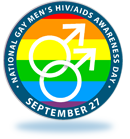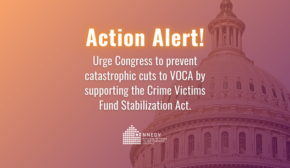Centering National Gay Men’s HIV/AIDS Awareness Day
September 26, 2016
While there has been increased awareness about domestic violence in same-sex relationships, the HIV risks for LGBTQ individuals experiencing abuse are often overlooked. On September 27, recognized as National Gay Men’s HIV/AIDS Awareness Day, the National Network to End Domestic Violence (NNEDV) recognizes the risk factors that make male victims of domestic violence in same-sex relationships susceptible to contracting HIV.
According to the CDC, 47 percent of bisexual men and 40 percent of gay men reported that they had experienced abuse from a violent partner in their lifetimes. [1] In the context of domestic violence, HIV transmission can occur as a result of forced unprotected sex or the victim’s lack of freedom to negotiate safer sex. [2] Many victims of domestic violence feel unsafe asking their abusive partners to use safer sex protection and are forced to comply with their abusers at the expense of their own health. [2] This poses a risk for all victims of domestic violence, especially men who have sex with men regardless of their sexual orientation (MSM).
In 2014, MSM accounted for 83 percent of the estimated new HIV diagnoses in men aged 13 and older and 67 percent of the total estimated new HIV infections in the United States, demonstrating that they are disproportionately affected by the HIV/AIDS epidemic. [4] According to the CDC, sexual risk behaviors account for most HIV cases in MSM, with unprotected receptive anal sex carrying the highest risk. The CDC suggests the best way to reduce this risk is to use condoms, but this option is often taken away by an abusive partner. [3] Studies have also shown that in some cases, although negotiations have appeared successful, MSM have been deceived by their partners into believing that a condom is being used, when one was not. [2]
NNEDV actively works to support all survivors, which includes those living with an HIV diagnosis. Our Positively Safe program aims to mobilize HIV/AIDS and domestic violence service providers to increase capacity and enhance linkage of care for individuals exposed to domestic violence and/or HIV/AIDS. Domestic violence programs can support survivors by incorporating safety planning strategies that include discussions about safer sex. By including this in their conversations, survivors can develop effective alternative plans of action that can help reduce risks of violence and HIV transmission. At the same time, HIV/STD services need to acknowledge the issues domestic violence poses for victims’ physical safety and sexual health in order to avoid encouraging safer sex tactics that may place victims at risk of further abuse.
Giving survivors all of the information they need to make the best and safest option for them is key to helping create an environment that is inclusive and informative. [2] To learn more about the intersection of HIV/AIDS and domestic violence, visit us at NNEDV.org/PositivelySafe.
—
[1] NISVS. “NISVS: An Overview of 2010 Findings on Victimization by Sexual Orientation.” 2010. Retrieved from: http://www.cdc.gov/violenceprevention/pdf/cdc_nisvs_victimization_final-a.pdf
[2] Journal of Interpersonal Violence. “Intimate Partner Violence and HIV/STD Risk Among Lesbian, Gay, Bisexual, and Transgender Individuals” (2006).
[3] HIV Among Gay and Bisexual Men, March 2013. Center for Disease Control (CDC). http://www.cdc.gov/hiv/pdf/risk_gender_238900B_HIV_Gay_Bisexual_MSM_FS_final.pdf
[4] HIV Among Gay and Bisexual Men, September 2016. Center for Disease Control (CDC) http://www.cdc.gov/hiv/group/msm/index.html





